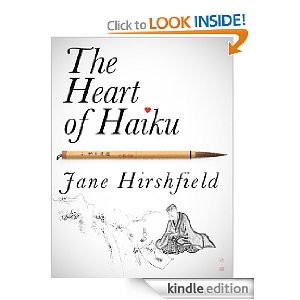One of the many reasons I love my Kindle is the treasure trove of new books and authors I find in the bargain bin at the Amazon and Barnes and Nobles Ebook Stores.
There, to generate interest in their projects, many newly published writers mark down prices to ninety-nine cents. What a deal!
Add in the fact that these stores offer the opportunity to “sample” a book before you buy it and book shopping becomes a win-win experience.
This past week I found the following gem: The Heart of Haiku by Jane Hirshfield. You can buy it here.
Jane Hirshfield is an award-winning poet and author of the now-classic Nine Gates: Entering the Mind of Poetry, as well as an equally classic book introducing earlier Japanese poetry, The Ink Dark Moon: Love Poems by Komachi and Shikibu, Women of the Ancient Japanese Court.
In The Heart of Haiku, Hirshfield presents the 17th-century Japanese poetry scene as a cross between a Surrealist “exquisite corpse” session and a sake-lubed rap-battle circuit. As Jason Kirk remarks, the book is ” an elegant and reverent exploration of an itinerant artist who wanted to renovate human vision by putting what he saw into a bare handful of mostly ordinary words, and… to renovate language by what he asked it to see.” As he says, Hirshfield’s inspires the reader “to drop everything, walk out in to the wide world, open your eyes, and find out for yourself that even the briefest form of poetry can have a wing-span of immeasurable breadth.”
The product description tells how in seventeenth-century Japan, the wandering poet Basho developed haiku, a seventeen-syllable poetic form now perhaps the most widely written type of poetry in the world. Haiku are practiced by poets, lovers, and schoolchildren, by “political haiku” twitterers, by anyone who has the desire to pin preception and experience into a few quick phrases. This essay offers readers unparalleled insight into the living heart of haiku—how haiku work and what they hold, and how to read through and into their images to find a full expression of human life and perceptions, sometimes profound, sometimes playful.
Although Hirshfield talks of more recent experimental versions and the original Basho practiced (the one in Japanese was heard more than written), she also describes the version with which westerners are more familiar: a three-line image-based poem of seventeen units, five on the first line, seven on the second, five on the third which evokes a season, either by name or association.
As a prose writer with very little training in or talent for the writing of poetry, I chose this more traditional style for my humble Haiku attempts offered below:
august lie
heat waves vibrate off
asphalt, create illusion
of quenchable thirst
daffodils
tender green chutes glimpse
yellow, purple promises
of returning spring
If I can do this, so can you.
Give it a try.



